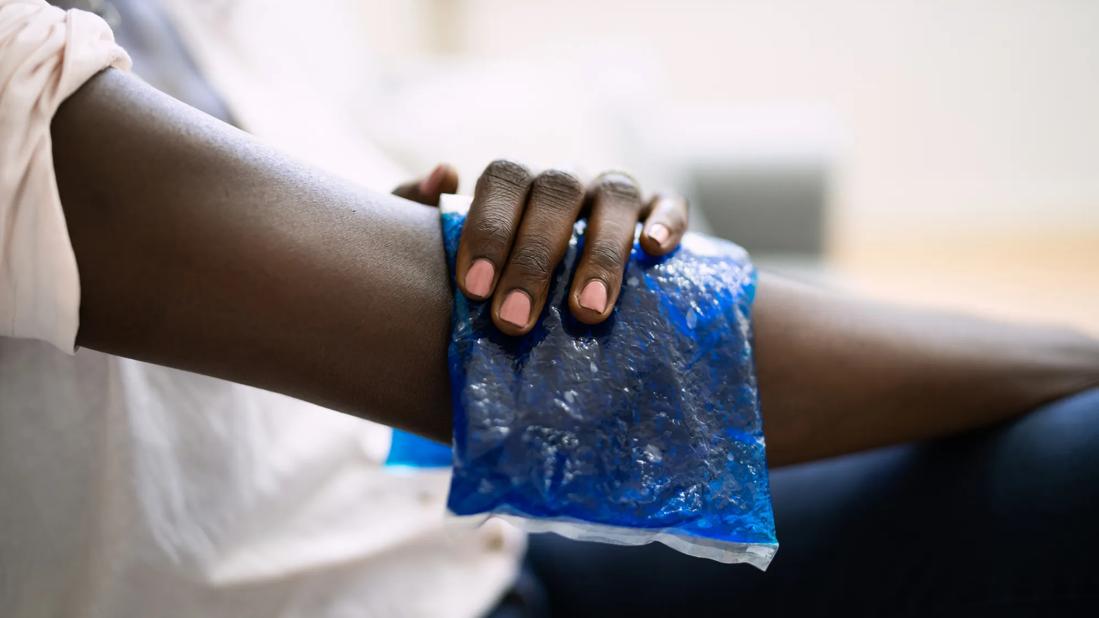20 minutes is the max — and you may actually need a lot less

A twisted ankle. A bent wrist. A wrenched back. We’ve all been there, groaning in agony after straining a joint or muscle — and an ice pack is usually one of the first things grabbed in search of relief.
Advertisement
Cleveland Clinic is a non-profit academic medical center. Advertising on our site helps support our mission. We do not endorse non-Cleveland Clinic products or services. Policy
Primary care sports medicine physician Anne Rex, DO, explains how long to ice an injury to maximize the benefits and minimize the risks.
When an injury occurs, it causes an inflammatory response in your body. “This response is part of the healing process, but it can be uncomfortable,” notes Dr. Rex. “Ice helps by halting inflammation.”
Applying cold to an injury:
Crushed ice or a frozen gel pack works best for icing because you can mold it around the injured body part, says Dr. Rex. If you don’t have that handy, a bag of frozen peas or carrots works well.
It’s always best to use a barrier such as a washcloth or a few layers of paper towels under any ice pack to protect your skin from the intensity of the cold.
Avoid icing areas that have:
Advertisement
Recommendations for icing injuries often vary given the lack of research on treating common sprains and strains. In general, though, the maximum icing time shouldn’t extend past 20 minutes. In many cases, 10 to 15 minutes is fine.
What happens if you ice for more than 20 minutes? Basically, you start undermining the healing process — which isn’t exactly the goal.
“Anything over 20 minutes can cause reactive vasodilation, or widening of the blood vessels, as your body tries to make sure your tissues receive blood supply,” says Dr. Rex. “Vasodilation can undo some of the benefits of icing an injury, so it’s counterproductive to ice too long.”
Signs that it’s time to remove the ice pack include:
Taking an icing session too far could lead to a cold-induced injury on top of your original owie. “The biggest risk is frostbite, or the milder version, frostnip,” cautions Dr. Rex. “Nerve injury can be a side effect of icing too long.”
That’s why you should only ice when you’re awake, too. Falling asleep with an ice pack on could result in a cold-related injury.
The appropriate amount of time to ice an injury also may vary based on:
You get the biggest benefit from icing if you start as soon as possible after the injury happens, Dr. Rex emphasizes. It’s OK to ice again, too, but space your 20-minute icing sessions at least one to two hours apart.
Keep icing off and on for two to four days if it seems to help, advises Dr. Rex. If swelling continues longer than that, consider going to urgent care or your healthcare provider. You may need X-rays to check for a fracture or other imaging tests to look for tears in connective tissue.
Advertisement
Learn more about our editorial process.
Advertisement

Your storm prep checklist should include making an evacuation plan, rounding up supplies and refilling prescriptions

Keep healthy foods on hand, like tuna packets, canned veggies and fruits, and beans and rice

Keep these items on hand for minor scrapes, burn, sprains and more

Looking down at your smartphone or computer screen can stress muscles in your neck, shoulders and back

Leg-related symptoms indicate DVT, while chest symptoms point to a pulmonary embolism

The emergency room is for serious medical issues; urgent care can help when you can’t get a quick appointment with your child’s doctor

Eat foods that are high in protein and low in animal fat and simple sugar

Raspberries are packed with nutrients that can reduce inflammation and prevent chronic diseases

The ‘sunshine vitamin’ is found naturally in some fish and is added to other foods

Autism and ADHD often go hand in hand, giving rise to the term AuDHD

The Yuzpe regimen is less effective than other forms of emergency contraceptives, and it’s associated with more side effects